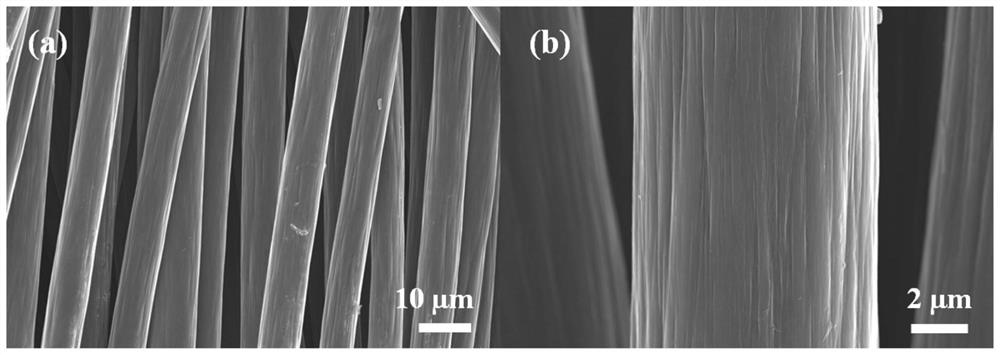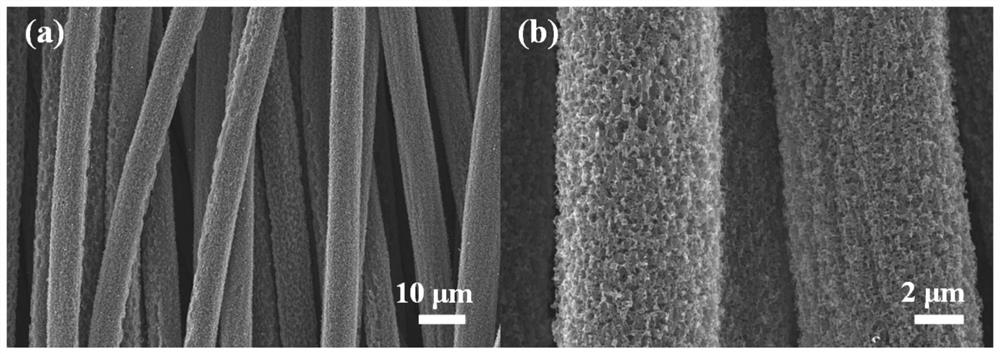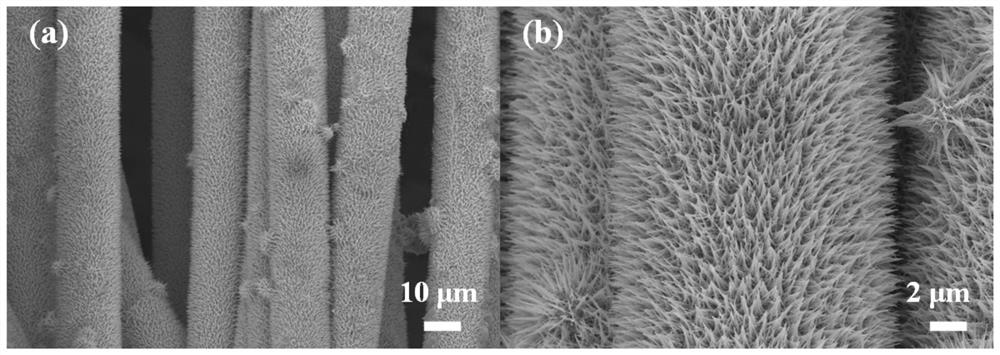Preparation method and application of porous carbon fiber/tungsten oxide self-supporting lithium-sulfur battery positive electrode material
A porous carbon fiber, lithium-sulfur battery technology, applied in battery electrodes, lithium storage batteries, positive electrodes, etc., can solve the problems of reducing active sulfur utilization, electron/ion kinetic performance, reducing battery energy density, increasing electrode internal resistance, etc. , to achieve the effect of shortening the electron/ion transmission path, excellent conductivity and low cost
- Summary
- Abstract
- Description
- Claims
- Application Information
AI Technical Summary
Problems solved by technology
Method used
Image
Examples
Embodiment 1
[0036] The preparation method of a porous carbon fiber / tungsten oxide self-supporting lithium-sulfur battery cathode material in this example is as follows:
[0037] 1. Commercial carbon cloth (CC) was ultrasonically treated with acetone, ethanol, and deionized water for 10 minutes, and dried at 60°C for 10 hours. CC was used as the working electrode, Pt was used as the counter electrode, and Ag / AgCl was used as the reference electrode. A three-electrode system was used. Electrodeposit nickel hydroxide, dry at 60°C for 10 hours, then reduce in nitrogen at 800°C at high temperature, heating rate 5°C / min, keep warm for 4 hours, then pickle with 3M hydrochloric acid for 6 hours, wash and dry to obtain porous carbon fiber cloth PCC;
[0038] 2. Weigh 1.75g (NH 4 ) 2 SO 4 , added to 30mL precursor solution containing tungsten source, wherein the precursor solution is 0.125MNaWO 4 and 0.1M H 2 C 2 o 4 After stirring the mixed solution for 1 hour, put the PCC obtained in Step...
Embodiment 2
[0052] The preparation method of a porous carbon fiber / tungsten oxide self-supporting lithium-sulfur battery cathode material in this example is as follows:
[0053] 1. Commercial carbon cloth (CC) was ultrasonically treated with acetone, ethanol, and deionized water for 10 minutes, and dried at 60°C for 10 hours. CC was used as the working electrode, Pt was used as the counter electrode, and Ag / AgCl was used as the reference electrode. A three-electrode system was used. A layer of nickel hydroxide was electrodeposited, dried at 60°C for 10 hours, then reduced in nitrogen at 800°C at a high temperature, the heating rate was 5°C / min, kept for 4 hours, then pickled with 3M hydrochloric acid for 6 hours, washed and dried to obtain porous carbon fiber cloth PCC;
[0054] 2. Weigh 1.75g (NH 4 ) 2 SO 4 , added to 30mL precursor solution containing tungsten source, wherein the precursor solution is 0.125MNaWO 4 and 0.1M H 2 C 2 o 4 After stirring the mixed solution for 1 hour...
Embodiment 3
[0058] The preparation method of a carbon fiber / tungsten oxide self-supporting lithium-sulfur battery cathode material in this embodiment is as follows:
[0059] 1. Commercial carbon cloth (CC) was ultrasonically treated with acetone, ethanol, and deionized water for 10 minutes, and dried at 60°C for 10 hours.
[0060] 2. Weigh 1.75g (NH 4 ) 2 SO 4 , added to 30mL precursor solution containing tungsten source, wherein the precursor solution is 0.125MNaWO 4 and 0.1M H 2 C 2 o 4 After stirring the mixed solution for 1 hour, arrange the carbon obtained in step 1 in the precursor solution, then transfer it to the reaction kettle, and conduct a hydrothermal reaction at 160°C for 8 hours. After the reaction, wash repeatedly, and dry at 60°C for 10 hours to obtain The carbon fiber cloth with tungsten oxide precursor grown on the surface is sent to a tube furnace for annealing treatment. Under an argon protective atmosphere, the temperature is kept at 400°C for 3 hours, and the ...
PUM
| Property | Measurement | Unit |
|---|---|---|
| diameter | aaaaa | aaaaa |
Abstract
Description
Claims
Application Information
 Login to View More
Login to View More - R&D
- Intellectual Property
- Life Sciences
- Materials
- Tech Scout
- Unparalleled Data Quality
- Higher Quality Content
- 60% Fewer Hallucinations
Browse by: Latest US Patents, China's latest patents, Technical Efficacy Thesaurus, Application Domain, Technology Topic, Popular Technical Reports.
© 2025 PatSnap. All rights reserved.Legal|Privacy policy|Modern Slavery Act Transparency Statement|Sitemap|About US| Contact US: help@patsnap.com



